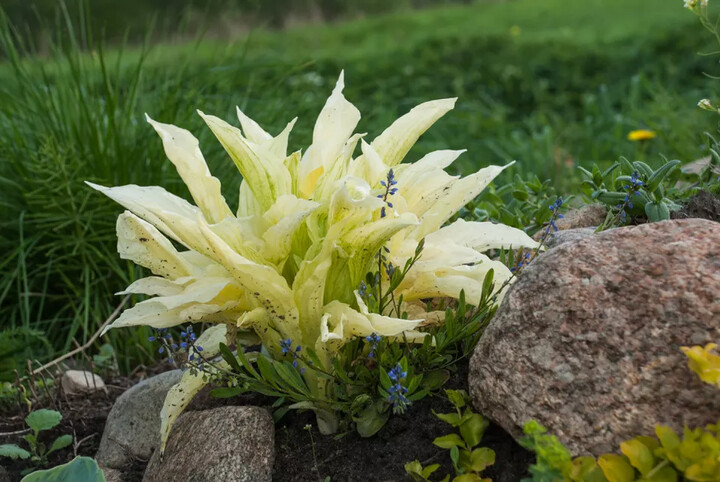A perfect addition to any shade garden, the white feather hosta is known for its unique foliage. Its leaves are white when opening and then over the course of the following weeks will transform into green-white.
In the mid-summer, fragrant and funnel-shaped lavender flowers will open up above the foliage. All-white leaves are very rare for a hosta plant, so they have become a must-have commodity for hosta enthusiasts.

These herbaceous perennial plants are primarily grown for decorative purposes. They make a great option for lightening up shaded gardens, as well as for planting in containers.
Whether you plant your white feather hostas indoors or outdoors, you can expect a magical color transformation in the summer months, when green pigment first becomes visible on its hosta leaves (first as green leaf veins, and then the entire leaf will become a pale green color). The plant's leaves will require that green pigment in order to fuel the photosynthesis process.
Botanical Name:
Liliaceae genus
Common Name:
White feather hosta
Plant Type:
Perennial
Mature Size:
20-24 inches
Sun Exposure:
Part shade/shade
Soil Type:
Slightly acidic/alkaline
Soil pH:
6.5-7.5
Bloom Time:
Mid-summer
Flower Color:
Lavender
Hardiness Zones:
3-9
Native Area:
Northeast Asia
White Feather Hosta Care
These plants are generally considered to be easy to grow, as they require minimal care and maintenance. However, anyone interested in cultivating white hosta plants should have a basic understanding of plant biology.
Since these plants lack chlorophyll, they grow slowly and in many cases will barely achieve full growth. All plants require these green pigments in order to make its own food, so at some stage of their growth, the white feather hosta must develop its own green tissue, or chloroplast, in order to survive.
Gardeners should also note that the thin white leaves of hosta plant are a delicacy for slugs and snails (as well as rabbits and deer), so you may have to employ protective measures including plastic bird netting, spraying, or slug baits.
Light
These plants cannot tolerate direct sunlight and will grow best in full shade. The white feather hosta must always be protected from the sun in order to prevent its thin, light-colored leaves from scorching.
Water
Most hosta plants require a larger amount of water than average. Just be sure not to drown the soil.
Soil
When planting your white feather hosta, choose a well-drained, humus-rich garden soil. They will grow best in a slightly acidic or slightly alkaline soil.
Temperature and Humidity
These shade-loving plants must always be sheltered from cold, dry winds. They are warm-weather plants that will not survive long after the first frost of the year.
Fertilizer
When planting a white feather hosta, gardeners will have to take additional steps to adequately enrich the soil with organic manure. Proper fertilization will help boost the soil's capacity to retain water, as well as improve soil nutrition--both of which are crucial to successfully growing these plants.
Propagating White Feather Hostas
Hostas can typically be propagated very easily, although it can be a challenge to divide its tough root clumps.
The plants can be divided in early spring or the fall by digging up the root ball and dividing it into small clumps of roots and leaves before replanting.
Related Varieties of Hostas
Fire Island Hosta: Prized for its golden leaves
Patriot Hosta: Two-toned foliage plant
Frances Williams Hosta: Trumpet-shaped, variegated leaves
Halycon Hosta: Among the most popular hosta; blue-green leaves
Pruning
The white feather hosta can be pruned in a few different ways. They can be deadheaded by using sharp shears to cut the flower stalks near the base of the plant, or they can be cut back after the first frost.
These plants can also be pruned to help deal with any damage done by pests. Simply remove any leaves that have already been eaten by slugs, rabbits, or any other insects or animals in the garden.
Growing in Containers
Since these plants must be kept in shaded environments, many gardeners will plant their white feather hostas in a large pot or container. This means they can easily move the plant around when needed to protect its leaves from the scorching sun or to transplant outdoors.